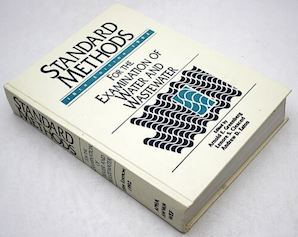 Curated with aloha by
Curated with aloha by
Ted Mooney, P.E. RET
 The authoritative public forum
The authoritative public forum
for Metal Finishing 1989-2025

-----
Sodium Bicarbonate Analysis
Q. I am looking for a procedure to test for concentration of Sodium Bicarbonate in my bath which is in the range of 12% by volume of Sodium Bicarb with DI water. The process will involve dissolved Iron in the bath. I need to control the concentration of BiCarb in the bath, so I can make ads where necessary.
I greatly appreciate any suggestions. Thank you.
Cindy Krause
Plating R & D - Auburn New York USA
November 5, 2008

|
A. Bicarbonate is a funny beast.
There is an equilibrium between dissolved, un-ionized CO2, bicarbonate ion, and carbonate ion. It depends on pH, TDS, and temperature - mostly pH. Carbonate buffering is largely responsible for maintaining the constant pH of 7.4 in our bodily fluids.
If I were you: I'd look at
<== 'Standard Methods ...'. There is a fairly involved discussion of carbonate solution chemistry. A careful, accurate pH measurement + two titrations with 1.0 N HCl (one to a methyl orange
⇦ this on
eBay or
Amazon [affil links]
endpoint - one to a phenolphthalein endpoint) will likely give you all the information you need to get a pretty accurate answer.
Depending on the matrix, you might get a better result using a titrimetric determination of carbonate (see "The Handbook of Metal Finishing") plus a pH determination.
Without more info on the kind of bath you're trying to test, it's tough to be more helpful.

Dave Wichern
Consultant - The Bronx, New York
November 10, 2008
November 10, 2008
A. Cindy,
I usually deal with carbonate not bi carbonate so I looked up a procedure. It is as follows:
1. Prepare sample as a 0.1N solution of bicarbonate in a stoppered volumetric flask without allowing the temperature to rise.
2. Take 25 ml of the above solution and add 30 ml of 0.1N alkali (carbonate free) and 10 ml of a 10% solution of barium chloride.
3. Titrate back to phenolphtalein with 0.1N acid. Also titrate a blank solution containing the same amount of alkali and barium chloride. The difference represents bicarbonate, each ml of solution corresponding to 8.4 mg of the sodium salt.
The above is from
<== 'Volumetric Analysis II' by Kolthoff and Stenger. I feel that a few bits of information were left out. First the 25 ml of the 0.1N sodium bicarbonate solution you remove should be by Mohr pipette
[pipettes on
eBay or
Amazon [affil links]
into a flask.
Second, the instructions a basically giving you the method which you then have to calculate against.
Different methods of analysis may be indicated depending upon what other chemistry is present in the solution to be analyzed.
Gene Packman
- Great Neck, New York
|
Disclaimer: It's not possible to fully diagnose a finishing problem or the hazards of an operation via these pages. All information presented is for general reference and does not represent a professional opinion nor the policy of an author's employer. The internet is largely anonymous & unvetted; some names may be fictitious and some recommendations might be harmful.
If you are seeking a product or service related to metal finishing, please check these Directories:




